If you’ve ever kept an aquarium or are considering it, this article is for you. Chances are that you already know of fish that have been derived from the tetra group.
However, as there are over 150 species of tetra, it’s very unlikely that you’ll have encountered every single one.
In fact, you might have only experienced one or two tetra varieties. There is still so much for you to see! Tetras come in different patterns, colors, shapes, and even textures.
In the wild, tetras are commonly native to Central America, South America, and East Africa. They’ll be found in freshwater systems, no matter how large or small they are.
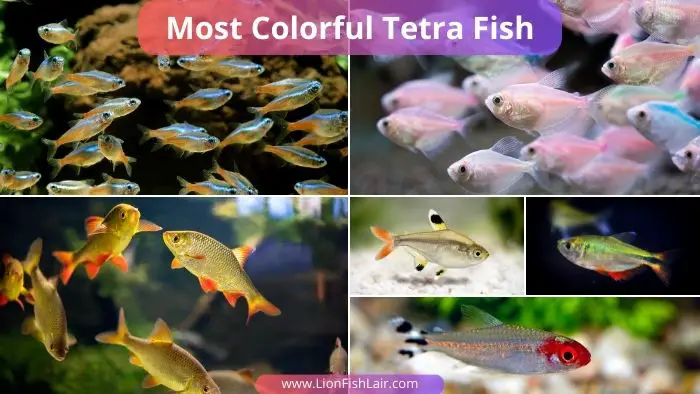
However, unlike many fish species, tetras won’t keep growing larger according to their environment.
Instead, tetras will rarely surpass 2.5 inches in length, making them incredibly petite and hard to spot in the wild. However, their tiny size makes them excellent aquarium inhabitants.
You can easily distinguish a tetra from other fish due to the fact that they have four pairs of fins rather than the more popular number of three pairs.
This additional pair of fins is called the ‘adipose pair’ and they sit between the caudal fins and dorsal fins.
The word ‘tetra’ is derived from the Greek word for four, which is a nod to their unusual number of fin pairs.
When thinking of a tetra, you’ll most likely picture a brightly colored fish with interesting patterns such as spots and stripes; however, this is not the only typical look for tetras.
Piranha and enormous pacu fish are also tetras, but they have a much more mellow appearance. These are not typically kept in aquariums.
Today we will be focusing more on the colorful tetras; however. We’ll be looking at 20 of the best subspecies to intrigue and excite anyone with a tetra aquarium or who’s looking to brighten up their tank.
Different Types of Tetras
Picture your dream tetra that you’d like in your tank. It can be any color(s), pattern, and shape. You’ll not often be able to design your ideal fish, but chances are that there is a tetra very close to what you’re currently thinking of.
There’s even a tetra that glows in the dark thanks to being bred with the GloFish. While these glow-in-the-dark effects do fade over time, the initial novelty is more than worth it.
You can keep different types of tetras in your tank without there being an issue, but bear in mind that they are schooling fish. This means that you need a big enough tank for them to be happy and content.
You’ll need an additional 2 gallons of space for each additional tetra you add to your tank. Tetras do best in schools of six or more, which is why they need so much more space.
Now let’s get into our list of 20 amazing tetras to excite any aquarist.
1. Black Widow Tetra (Gymnocorymbus ternetzi)
The black widow tetra is one of the most popular types of tetra to keep in aquariums. They’re also considered one of the most popular fish for freshwater aquariums.
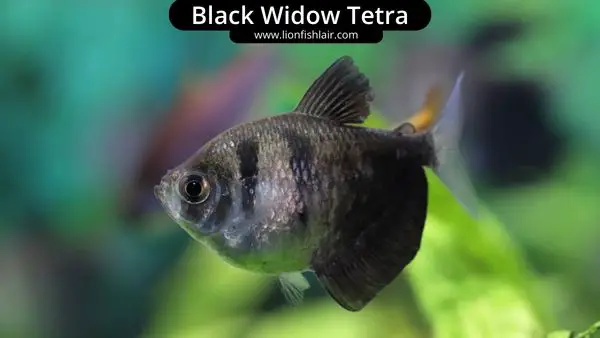
- Difficulty rating: Easy
- Dietary needs: Omnivore
- Personality: Friendly and peaceful
- Tank requirement: 20 gallons, 75 liters
A black widow tetra is easy to distinguish thanks to their black and white patterns with a long, flowing fin below their tails. This fin is also why they might be referred to as the black skirt tetra.
Originating from South America, black widow tetras enjoy a neutral pH level compared to some other tetras from the same area.
These tetras will only reach a size of 3 inches, although this makes them one of the larger tetras to be kept in an aquarium. Although piranhas are much larger, they shouldn’t be kept in an aquarium.
The black widow tetra’s colors will fade as they age, but the pattern will remain the same. A black widow with grey coloring rather than black is considered to be older. For the best health and least amount of stress, black widows should be kept in a school of at least five.
Black widow tetras are hardy fish and will eat almost anything, so you don’t have to worry about their diets too much. If you’re a beginner aquarist, the black widow tetra is an excellent option for you.
2. Diamond Tetra (Moenkhausia pittieri)
Diamond tetras mature into gorgeous fish, despite their start in life being rather bland in their looks. The mature fish will be colored grey, black, and yellow with iridescent scales that make this fish gleam in the right lighting, just like a diamond.

- Difficulty rating: Easy
- Dietary needs: Omnivore
- Personality: Content
- Tank requirement: 20 gallons, 75 liters
Diamond tetras can exist well in community tanks. In fact, when placed with other colorful tetras, you’ll really be able to notice their gemstone look.
These fish can get rather bored; however, so you’ll need them to be in a school of at least eight to make sure that they don’t start nipping your other fish.
Diamond tetras are easy to care for and even easy to breed. Many aquarists consider this type of tetra to be the easiest to manage when it comes to breeding, even for beginners of the craft.
3. Neon Tetra (Paracheirodon innesi)
If you’ve only heard or seen one type of tetra, we’ll bet that it was a neon tetra. These fish are iconic among aquarists and are sold at almost every pet store.
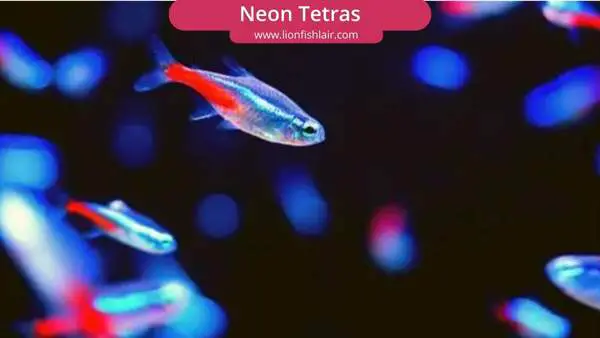
- Difficulty rating: Easy
- Dietary needs: Omnivore
- Personality: Friendly
- Tank requirement: 15 gallons, 56 liters
You can spot a neon tetra thanks to their silver line down their sides, and split blue and red coloring. Their fins will all be translucent and blue, although the cardinal fins will have a splash of red at the base.
Neon tetras will reach a size of 1.5 inches, making them a midsize tetra and ideal for smaller tanks. They can be kept in communal tanks without any issues, as long as all of the other fish are peaceful and freshwater.
Neon tetras are amazing for beginners thanks to their hardy nature and easy to care for needs. This type of tetra can live up to 10 years as long as you care for them properly. Their coloration is complimented very well by the introduction of guppies, both neon tetra and guppies are brilliant tank mates.
4. Lemon Tetra (Hyphessobrycon pulchripinnis)
The lemon tetra isn’t the most interesting of tetras to look at, despite their name hitting that they’ll have bright yellow scales. This is not the case. Instead, these triangular fish are mostly silver with yellow dorsal fins. They’re still gorgeous tetras, but many will pass by them without a second look.
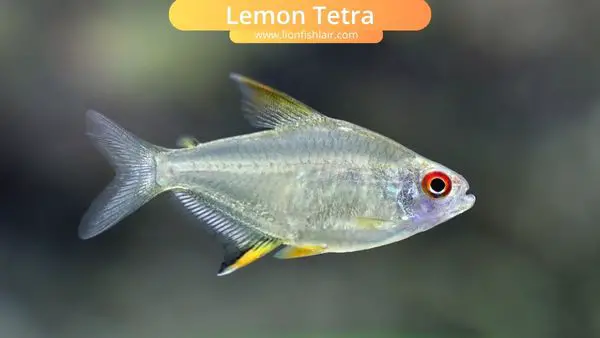
- Difficulty rating: Easy
- Dietary needs: Omnivore
- Personality: Content
- Tank requirement: 20 gallons, 75 liters
Lemon tetras also have red scales around their eyes, which works as a warning system for their health and mood. If the color of these scales turns dull, it’s usually a sign that they’re either ill or unhappy. This makes them good for beginners.
This type of tetra does best when kept in a school of at least six so that they can satisfy their schooling instinct. Keeping more females than males will prevent too many fights from starting, especially during the mating season.
5. Penguin Tetra (Thayeria boehlkei)
There are two reasons why these tetras are called penguin tetras. The first is their white and black pattern, although this can be seen on other tetras. The other reason is that these fish swim in a slightly vertical pattern, which is quite unusual for fish.
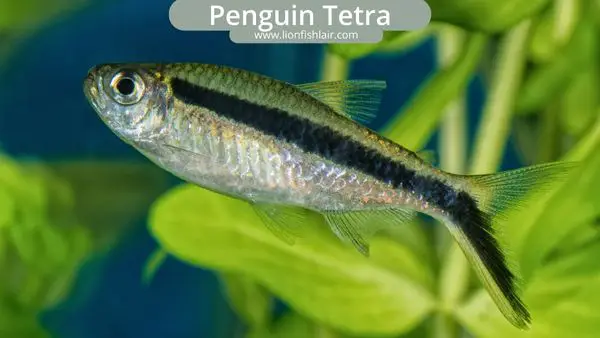
- Difficulty rating: Easy
- Dietary needs: Omnivore
- Personality: Peaceful
- Tank requirement: 20 gallons, 75 liters
Penguin tetras are found on the floodplains of the Amazon Basin, where they’ll feed on worms, insects, floating plants, and more. Many birds and reptiles will try and feed on them; however, they stick near the roots of vegetation for protection.
A school of five penguin tetras is best to keep them protected and happy in their tank. Alternatively, they can be kept in community tanks with other fish of similar sizes and personalities.
6. Emperor Tetra (Nematobrycon palmeri)
Emperor tetras are most impressive when kept in tanks full of darkly colored decor and substrates.
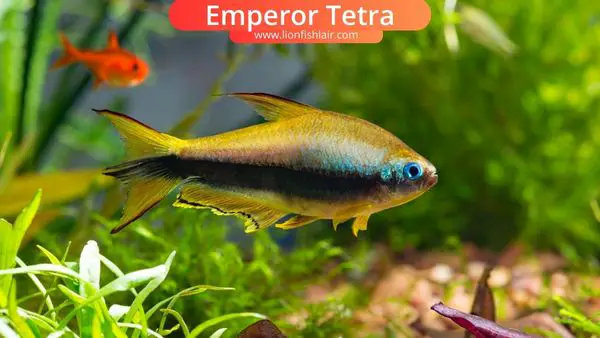
- Difficulty rating: Moderate
- Dietary needs: Omnivore
- Personality: Peaceful
- Tank requirement: 10 gallons, 37 liters
The emperor tetra has a distinctive dark stripe below the lateral line. This is commonly seen with tetras, so you can’t always use this to find an emperor tetra. However, this type of fish will have red, yellow, and blue splashes on their bodies.
These colors might not be able to be seen all the time, but they will catch the light as the fish swims around and become more prominent.
The fins are another way to distinguish emperor tetras from other types, as their caudal and dorsal fins will be much longer and have more prominent points at the tips. The caudal fins (at the tail) also have a central ray in between them, making the tail look like a trident.
Emperor tetras are native to Columbia and require you to mimic these water conditions accurately. You also need to take care with the filter you choose as they’ll prefer a slower current. A fast filter might put unnecessary stress on them.
7. X-ray Tetra or Pristella Tetra (Pristella maxillaris)
This is a very intriguing tetra due to its translucent scales. You can see the internal structure of x-ray tetras if you can get them to stay still for long enough! They’re also distinguishable thanks to the black horizontal stripes over their dorsal fins.
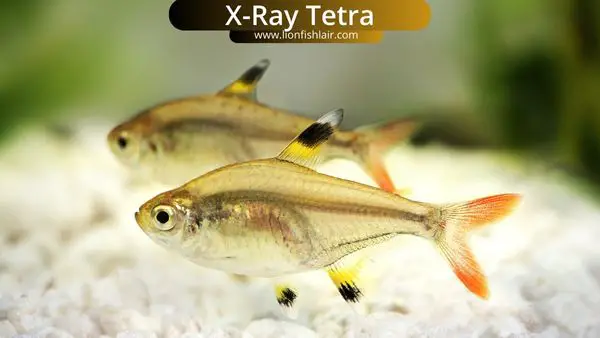
- Difficulty rating: Easy
- Dietary needs: Omnivore
- Personality: Happy and friendly
- Tank requirement: 10 gallons, 37 liters
Pristella tetras have a Weberian apparatus, which is an anatomical structure connecting the swim bladder to the auditory system. Catfish also have this structure, and it allows the tetra to pick up sound waves through the water. This makes them excellent at approaching predators.
X-ray tetras should be kept in shoals of six or more fish. These tetras don’t like to be confronted by too many school members; however, so don’t overdo the numbers.
They also don’t like too many larger fish in the tank. Not listening to these conditions will cause them to get stressed and hide.
8. Ember Tetra (Hyphessobrycon amandae)
As their name suggests, ember tetras have bright orange colorings across their translucent scales. The orange color can look amazing against the background of a planted aquarium.
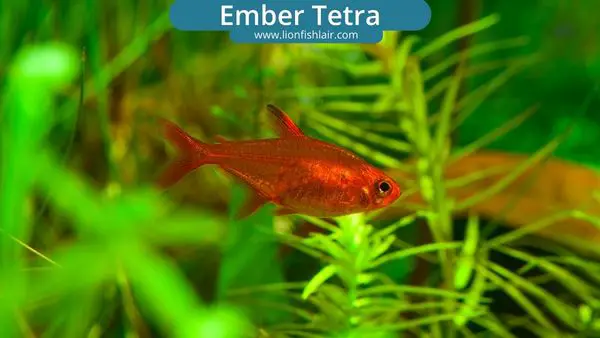
- Difficulty rating: Easy
- Dietary needs: Omnivore
- Personality: Content
- Tank requirement: 10 gallons, 37 liters
These fish are nippy little things, with a length of around only one inch. They are happiest when in tightly packed schools, and this allows you to really see a spectacle when they all dart around the tank at once. It’ll look like a fireball racing through the water!
Make sure that you have enough hiding spots for your ember tetras, as they enjoy time to themselves, especially when they think they’re in danger of larger tankmates.
Ember tetras have great personalities that are much larger than their physical size. Many aquarists believe that their ember tetras try to goad them into feeding them extra food.
While this is a great thing to see, be careful not to give into them and overfeed them. This can lead to health issues and reduce their lifespan.
9. Cardinal Tetra (Paracheirodon axelrodi)
Similar to the neon tetra, cardinal tetras have vibrant two-toned patterns and are colored blue and red. However, these colors are split with the iridescent lateral line on both sides of their bodies, with the top half being blue and the bottom being red. In the right lighting, their lateral line will sparkle.
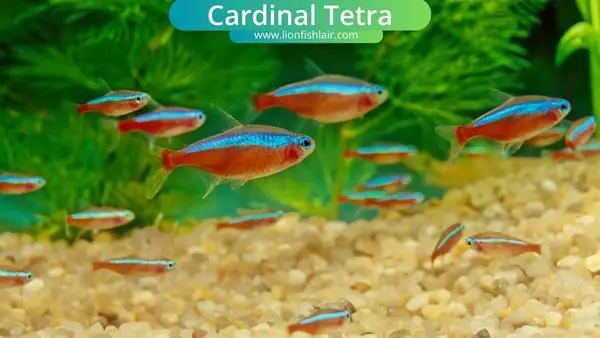
- Difficulty rating: Moderate
- Dietary needs: Omnivore
- Personality: Peaceful
- Tank requirement: 10 to 20 gallons, 37 to 78 liters
Cardinal tetras are one of the smaller types of tetras out there, with a mature length of only 1.5 inches. However, you might have one that will grow much longer. Due to their smaller size, these fish depend on their schools to keep them safe.
Many people confuse cardinal tetras with neon tetras, and this can be unfair on these little fish. Larger, more aggressive fish will often bully cardinal tetras, and while neon tetras will be able to defend themselves, cardinals might not.
10. Glowlight Tetra (Hemigrammus erythrozonus)
Again, glowlight tetras are another one of the most popular tetra species. They have silver bodies with an iridescent orange stripe along their lateral line. This gives a similar look to a filament lightbulb. If you have a dark background and low lighting, this tetra might even glow.
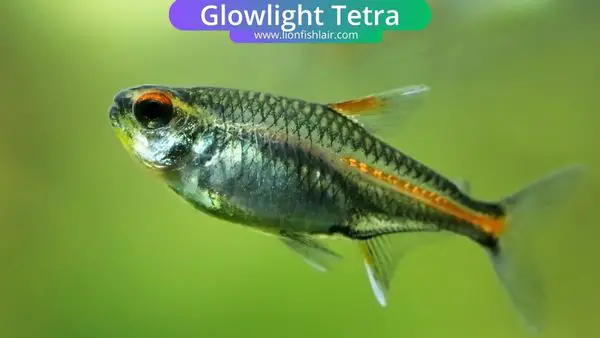
- Difficulty rating: Easy
- Dietary needs: Omnivore
- Personality: Peaceful and friendly
- Tank requirement: 10 gallons, 37 liters
Glowlight tetras are rather shy, so they’ll need a proper tank set up with plenty of hiding spots and dark colors. They’re commonly found in Guyana rivers, which are full of tannin and vegetation.
So, being brought into a brightly colored tank with lots of fake decor can be quite stressful.
Floating plants are good to use in a tank with glowlight tetras to avoid too much light from disturbing them.
These tetras will also require specific tankmates, as they’re too shy to coexist with predatory species. Also, mixing glowlight tetras with angelfish is a recipe for disaster. Seriously, angelfish will eat your glowlight tetras, so keep them apart.
11. Bleeding Heart Tetra (Hyphessobrycon erythrostigma)
You’ll notice that this tetra has a light red line along its lateral line with a prominent red dot over its heart. This pattern makes it look like their hearts are bleeding, thus where it gets its name from.
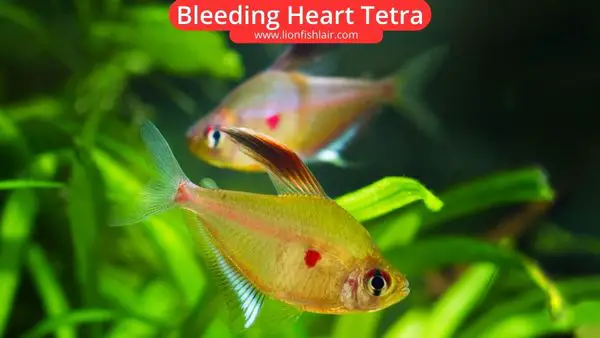
The red dot is actually nowhere near the bleeding heart tetras heart, but it looks like it should be and that was enough for the name to stick.
- Difficulty rating: Easy
- Dietary needs: Omnivore
- Personality: Peaceful
- Tank requirement: 20 gallons, 75 liters
Bleeding heart tetras are happy in schools of four to six. Any more than this number and they might start nipping one another, which can lead to health complications.
This type of tetra is less dependent on their schools and will often check in with one another briefly before parting to explore the tank on their own. They can also be kept with any fish and remain happy, as long as the other fish aren’t aggressive.
Bleeding heart tetras can also co-exist with freshwater invertebrates such as shrimp or snails without disturbing them.
12. Rummy Nose Tetra (Hemigrammus rhodostomus)
This might be our favorite name for a tetra yet. Rummy nose tetras get their name from the red coloring at the tip of their heads. This can be likened to when a person has a cold with a red, runny nose.
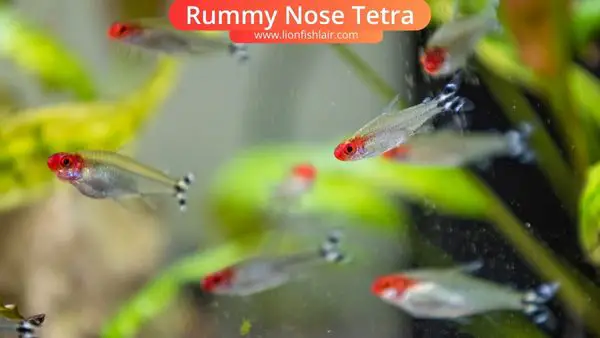
The rest of their bodies are silver with small and compact scales that will sparkle when they catch the light. They’ll have a white and black patterned tail, too. Compared to a lot of other tetras, the rummy nose tetra is definitely one of the most interesting to look at.
- Difficulty rating: Moderate
- Dietary needs: Omnivore
- Personality: Peaceful
- Tank requirement: 20 gallons, 75 liters
Rummy nose tetras grow to around 2.5 inches, which is slightly larger than the average tetra. They also have impressive lifespans of eight years, provided you care for them sufficiently.
These tetras need to be kept in schools of at least six to keep them happy and content, avoiding the stress that could be detrimental to their health. Rummy nose tetras swim in unison with their school which can create magnificent displays across your fish tank.
13. Congo Tetra (Phenacogrammus interruptus)
As you might have already guessed, the congo tetra originates from the Congo River in Africa. They have large scales that come in a pattern of yellow, blue, green, or red coloring. They also have long and flowing fins. The male congo tetras will have a brighter coloration.
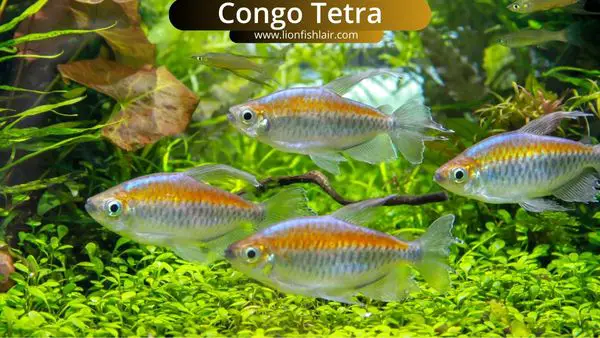
- Difficulty rating: Moderate
- Dietary needs: Omnivore
- Personality: Content
- Tank requirement: 40 gallons, 151 liters
Congo tetras are the larger size for tetras, reaching 3 inches in length. This means that they’ll need more space in the tank to accommodate their extra size. You’ll also need to keep them in a proper school, which also adds to the size requirement of your tank.
This type of tetra can often be kept in a community tank, but be sure to keep an eye on nippy fish. Congo tetras flowing fins are the ideal target for nippy fish, so they might not get on with every tank mate.
To keep your congo tetras looking their best, feed them some quality protein every now and then. Good examples of this are bloodworms, brine shrimp, Tubifex, or Daphnia. These will keep their scales bright and colors vibrant.
14. Buenos Aires Tetra (Hyphessobrycon anisitsi)
Buenos Aires tetras are less vibrant than some other tetras on our list, but they still sport bright red fins that can be truly admired against a black background.
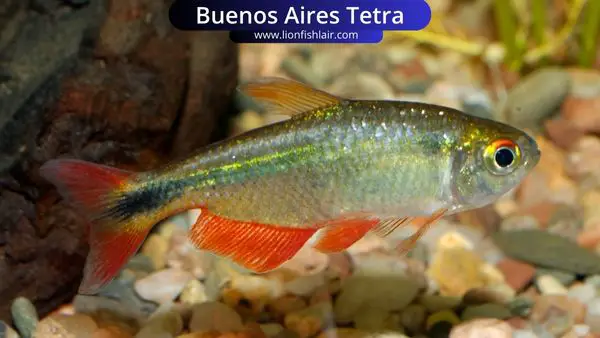
- Difficulty rating: Easy
- Dietary needs: Omnivore
- Personality: Slightly aggressive
- Tank requirement: 30 gallons, 113 liters
As you can see, the Buenos Aires Tetra is more aggressive than the other types we’ve looked at so far. This isn’t to say that they will fight other fish to the death, but they might nip slower fish to assert their dominance.
To avoid this, make sure that you keep this tetra with faster fish. Alternatively, you can keep Buenos Aires fish in large enough schools that they are too focused on one another to bother with your other fish.
Choosing the latter might mean that they fight one another to establish dominance. However, they shouldn’t hurt one another and it will keep them from nipping your other freshwater fish.
This tetra is slightly larger than the average with a length of 2.8 inches at maturity. However, they are still not as large as other freshwater fish you can find.
Buenos Aires tetras also need to be kept in warmer temperatures as well, which is another way that they differ from other tetras. They will tolerate unheated tanks, but if the temperature drops below 77 degrees Fahrenheit for too long, they will become more susceptible to infection.
15. Serpae Tetra (Hyphessobrycon eques)
Serpae tetras can sometimes be confused with red phantom tetras thanks to their red scales and black thick line near their gills.
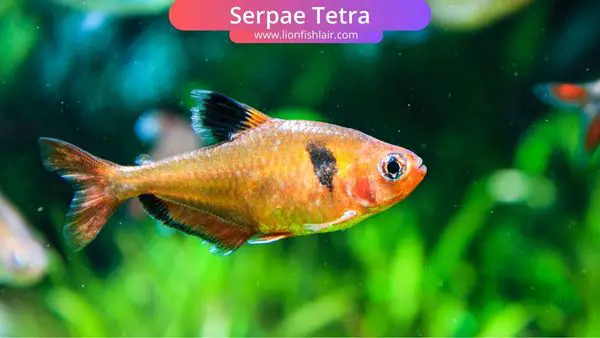
However, you can distinguish between the two by looking at the shape of this line. Serpae tetras have more of a comma shape to this line, while red phantom tetras have a softer line.
- Difficulty rating: Easy
- Dietary needs: Omnivore
- Personality: Peaceful
- Tank requirement: 20 gallons, 75 liters
As serpae tetras mature, it’s not uncommon for them to lose vibrancy in their colors. The black spot will also fade and begin to turn grey.
This can also be a distinctive difference between the serpae and red phantom tetra, although you’ll only pick up on this later in their lives.
Serpae tetras should remain in schools of six, and they’ll make you regret it if you skimp on this key factor. They might start nipping at fins, both of their own kind and their other tankmates. To prevent this, make sure that they have a good enough school system.
16. Blue Tetra (Boehlkea fredcochui)
Blue tetras are interesting as they don’t conform to the traditional mold that most other tetras do. Rather than having more than one color, blue tetras only boast one.
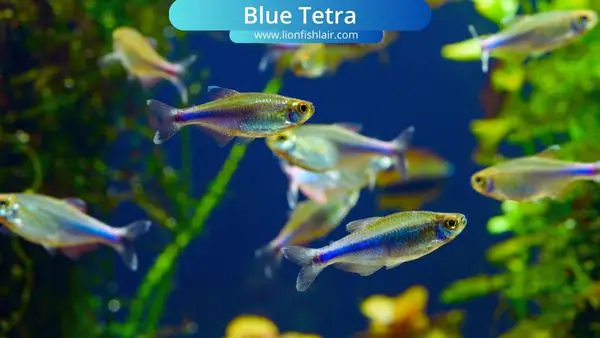
You’ll see that their bodies are either purple or blue, with the color being more prominent and opaque along its lateral line. In the light, however, they will shimmer with iridescence.
- Difficulty rating: Easy
- Dietary needs: Omnivore
- Personality: Peaceful
- Tank requirement: 20 gallons, 75 liters
Blue tetras won’t grow larger than 2.3 inches, and they have a life expectancy of between three or four years. This is provided that you keep them happy and the water in optimal conditions. They’ll need to be kept in shoals of six or more.
Blue tetras are peaceful by nature, but they can be destructive when they want to be. If they’re in an overcrowded tank they’ll be prone to nipping other fish - particularly if their tank mates have elongated fins.
To avoid this, try and keep your blue tetras as stress-free as possible.
17. Flame Tetra (Hyphessobrycon flammeus)
The flame tetra has a similar look and even name to the ember tetra, so be careful not to confuse the two. Flame tetras have a more vibrant red and orange coloration on their tail-ends, with a few black stripes over their heads.
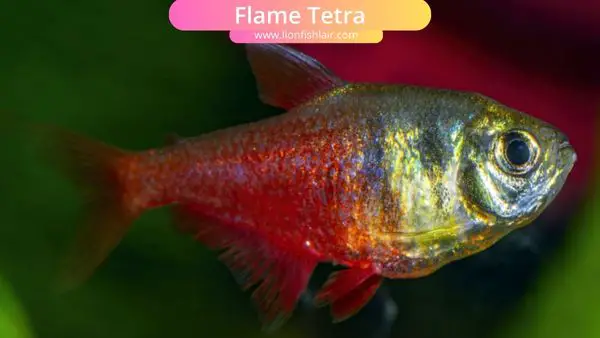
- Difficulty rating: Easy
- Dietary needs: Omnivore
- Personality: Content
- Tank requirement: 10 gallons, 38 liters
Flame tetras are found in Brazil throughout their coastal rivers. For this reason, they prefer tanks with sandy bottoms. Similarly, they don’t need too much water current either. Mimic a river with a gentle current that won’t pull them around too much.
This type of tetra prefers lower lighting in their tanks, so make sure that there is plenty of vegetation to block out some of the light. You can also dim the lighting slightly, just enough to keep your plants alive but have your tetras happy and stress-free.
18. Black Phantom Tetra (Megalamphodus Megaloptera)
Black phantom tetras have obvious black spots behind their gills, which is why they have been given their name. The red phantom tetra (Hyphessobrycon sweglesi) has the same pattern. The only difference between these two fish is their base colors.

- Difficulty rating: Moderate
- Dietary needs: Omnivore
- Personality: Peaceful and gentle
- Tank requirement: 10 gallons, 37 liters
Male phantom tetras are more boisterous than other tetra types, and they’ll often battle for dominance within their schools. They often won’t injure one another in these battles so it’s not something you need to be concerned about.
Phantom tetras often enjoy mirroring one another, which is very interesting to observe. In the wild they’ll be found in large schools, so you’ll want them in no smaller groups than eight.
This type of tetra is also very jumpy and will escape the tank if they’re given the chance, so make sure that they have enough water and a good amount of coverage. When opening the tank you’ll need to monitor the area around the tank.
19. Bloodfin Tetra (Aphyocharax anisitsi)
Another longer tetra, bloodfin tetras measures around two inches long. They have bright red tips of their fins which is most noticeable when they’re darting quickly around the tank. Keeping them with a school of six will make this spectacle even more impressive.
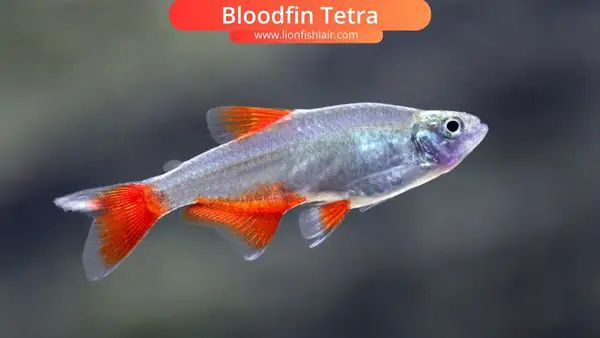
- Difficulty rating: Easy
- Dietary needs: Omnivore
- Personality: Content
- Tank requirement: 30 gallons, 113 liters
Bloodfin tetras tend to remain near the top of your aquarium as this is where you’ll often find them in the Paraná River, which is where they’ll be found in the wild.
This type of tetra is very jumpy and will try and escape your aquarium if they get scared, so you’ll need a tight lid on the tank.
Bloodfin tetras are hardy and might be able to live in a tank without a heater. However, you’ll find that their color is more impressive when you keep the water around 80 degrees Fahrenheit.
20. Mexican Tetra or Blind Cave Tetra (Astyanax mexicanus)
Mexican tetras are less interesting when it comes to their pattern, but they stand out from the rest thanks to one unique difference. They are blind! Where their eyes should be is completely covered. They are light pink in color, but due to their tank conditions, you might hardly see this.

- Difficulty rating: Easy
- Dietary needs: Omnivore
- Personality: Content
- Tank requirement: 20 gallons, 75 liters
There are two types of Mexican tetras - one with eyes and one without. If your Mexican tetras are exposed to sunlight, there is a chance that they will develop eyes. However, if there is no sunlight, they will not.
Both of these types of Mexican tetras can live in a communal aquarium without any issues. They’ll use their scent and their lateral line to get around and sense danger. Just make sure that these fish are not kept with predators that might take advantage of their blindness.
Mexican tetras are incredibly hungry and will eat anything they can find - so don’t skimp on the food. Once they’ve found a food source, they might not allow the rest of the fish to get their hands on any!
Tetra Tank Setup
Tetras are found in the wild in lakes, rivers, ponds, and wetlands. These waters are often bottom-lined with thick beds of vegetation, both from live plants and leaf litter from trees around the water.
To mimic this, you can add any dark, dried leaf litter to the bottom of your aquarium as a substrate.
Tetras love to swim, and you’ll rarely find a tetra that rests for long periods of time (unless they are ill or unhappy). This means that you’ll need a good filter with a medium to fast water current that helps mimic their natural habitat.
This is true for almost every tetra unless we have specified that this is not the case earlier in our article. Tetras found in ponds and lakes will require a slower water current as they’re not used as such a fast-paced alternative.
Live aquatic plants are excellent additions to your tetra tank as they help the tetra’s colorings to stand out the most. Keeping live plants in your tetra tank is a good idea too, as tetras won’t typically uproot these plants or destroy them through nipping.
The best live plant decor for tetra tanks includes amazon sword, java fern, anacharis, Brazilian pennywort, anubias.
Water Conditions for Tetras (Table)
Tetras are found in tropical areas of the world, so you’ll need to keep the water heated to an optimal temperature for them. Depending on where each type of tetra is found, you’ll need to adjust your tetra heater to the appropriate temperature.
Below we have included a number of factors that need to be considered with the water of your tetra tank, including temperature, pH level, hardness, and more.
Tetra | Temperature | pH | Hardness | Nitrates | Ammonia | Nitrates |
Black widow tetra | 75-80°F (24-26°C) | 6.0-7.5 | 5-20 dH | 0 ppm | 0 ppm | <40 ppm |
Diamond tetra | 72-82°F (22-28°C) | 5.5-7.0 | 2-15 dH | 0 ppm | 0 ppm | <40 ppm |
Neon tetra | 70-82F (21.1-27.7C) | 4.0-7.5 | 1-12 dH | 0 ppm | 0 ppm | <40 ppm |
Lemon tetra | 72-82°F (22-28°C) | 5.5-8.0 | 3-20 dH | 0 ppm | 0 ppm | <40 ppm |
Penguin tetra | 72-82F (22-28°C) | 6.0-8.0 | 5-20 dH | 0 ppm | 0 ppm | <40 ppm |
Emperor tetra | 73-81°F (23-27°C) | 5.0-7.8 | 5-25 dH | 0 ppm | 0 ppm | <40 ppm |
X-ray tetra | 75-82°F (24-28°C) | 6.0-8.0 | Up to 20 dH | 0 ppm | 0 ppm | <40 ppm |
Ember tetra | 68-82°F (20-28°C) | 5.0-7.0 | 1-10 dH | 0 ppm | 0 ppm | <40 ppm |
Cardinal tetra | 73-81°F (23-27°C) | 3.5-7.5 | 1-12 dH | 0 ppm | 0 ppm | <40 ppm |
Glowlight tetra | 74-82°F (23-28°C) | 5.8-7.5 | Up to 15 dH | 0 ppm | 0 ppm | <40 ppm |
Bleeding heart tetra | 72-80°F (22-26°C) | 6.0-6.5 | 4-8 dH | 0 ppm | 0 ppm | <40 ppm |
Rummy nose tetra | 76-80°F (24-27°C) | 5.5-7.0 | 2-15 dH | 0 ppm | 0 ppm | <40 ppm |
Congo tetra | 73-82°F (23-28°C) | 6.0-7.5 | 3-18 dH | 0 ppm | 0 ppm | <40 ppm |
Buenos Aires tetra | 64-77°F (18-25°C) | 5.5-8.5 | 1-20 dH | 0 ppm | 0 ppm | <40 ppm |
Serpae tetra | 72-79°F (22-26°C) | 5.0-7.8 | 5-25 dH | 0 ppm | 0 ppm | <40 ppm |
Blue tetra | 72-82°F (22-28°C) | 5.5-7.0 | 5-12 dH | 0 ppm | 0 ppm | <40 ppm |
Flame tetra | 72-82°F (22-28°C) | 5.8-7.8 | 5-20dH | 0ppm | 0ppm | <40ppm |
Black phantom tetra | 72-82°F (22-28°C) | 6.0-7.5 | Up to 18 dH | 0 ppm | 0 ppm | <40ppm |
Bloodfin tetra | 70-80F (22.2-26.6C) | 6.0-8.0 | 3-21 dH | 0 ppm | 0 ppm | <40 ppm |
Mexican tetra | 68-77°F (20-25°C) | 6.0-7.5 | 30 dH | 0 ppm | 0 ppm | <40 ppm |
Any ammonia found in your tank water will start to bleach the skin of tetras, and they will also begin adversely reacting to it. It is important that if you notice your tetras breathing quicker or their scales becoming lighter, check the water quality to see if you need to remove any ammonia.
Suitable Tank Mates
Tetras can play together well and most of them can coexist without any issues. You can even mix them with tetras from different regions to create an amazing aquarium. However, if you want to add other fish to the tank, you can also do this relatively easily.
Tetras are generally quite peaceful and content, so they are ideal tankmates for fish of similar sizes. These can include guppies, platies, and mollies. Larger tetra can be paired with discus, corydoras, dwarf cichlids, and danios. Always look for fish with calm and gentle natures to pair tetras with. Stay away from aggressive fish and species that are considerably larger than your tetras.
